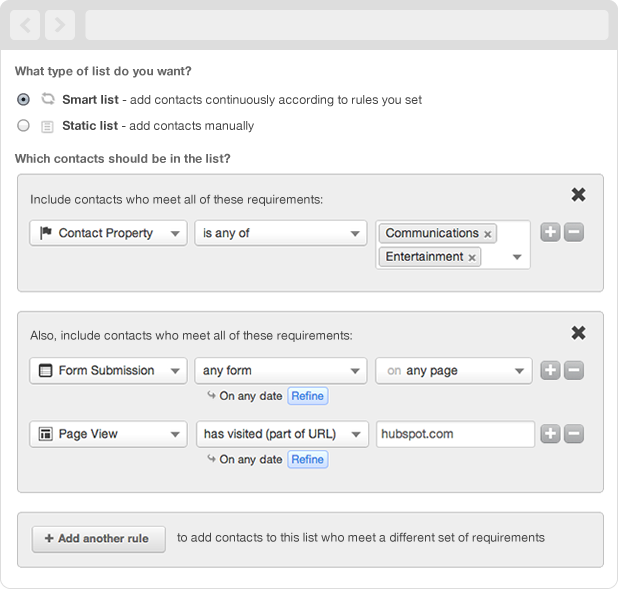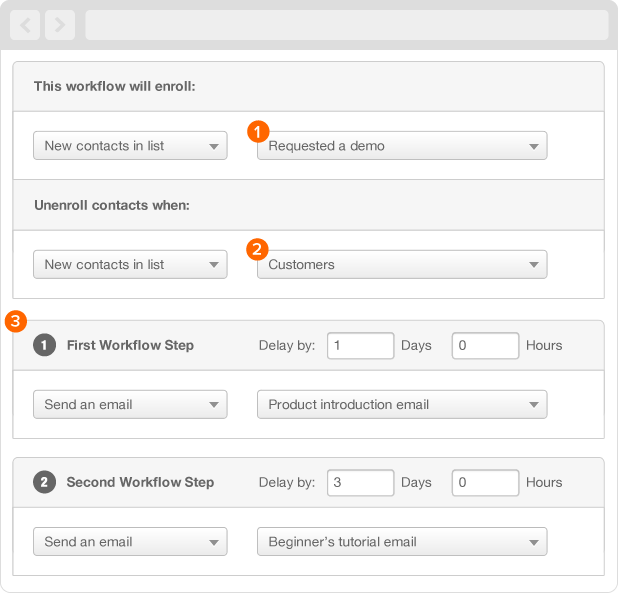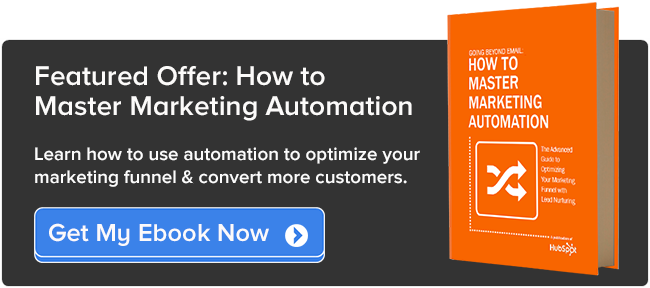5 Simple Ways to Boost the Impact of Your Marketing Automation Workflows
5 Simple Ways to Boost the Impact of Your Marketing Automation Workflows:
from HubSpot's Inbound Internet Marketing Blog
 We've talked about the basics of marketing automation workflows quite a few times before. If you're reading this post, you are probably already running a few workflows. So I'm not going to talk about how to get them started -- though if you want a refresher, here is a pretty comprehensive guide. Instead, I want to talk about what to do after you've got a few workflows under your belt.
We've talked about the basics of marketing automation workflows quite a few times before. If you're reading this post, you are probably already running a few workflows. So I'm not going to talk about how to get them started -- though if you want a refresher, here is a pretty comprehensive guide. Instead, I want to talk about what to do after you've got a few workflows under your belt.
I think many marketers (myself included) get so excited that they have some workflows running in the first place that they kind of forget about them once they are set up. Lots of people don't spend time optimizing those workflows or asking questions about whether those workflows were set up correctly in the first place, even though spending some time optimizing workflows can really improve your marketing efforts.
So if you understand how workflows work and you've implemented a few, you're ready for the next step: making workflows work harder, better, faster, stronger for your business. (Because when I think workflows, I think Kanye. Or Daft Punk. Whichever you prefer.)
How to Kick Your Workflows Up a Notch
Before writing, I spoke with some internal experts on workflows -- Maggie Georgieva, Matthew Wainwright, and Sarah Goliger. These optimization recommendations are based on their experiences and what they've found to have the biggest impact in workflow optimization.1) See how many active contacts you have in each workflow.
This is an easy one to start with. (I'm a big fan of easing into workflow optimization. It makes it seem more accessible.) Many marketers start setting up workflows for things that really don't need workflows yet. Seeing how many active contacts you have enrolled in your workflows will help you identify which workflows are suffering from a top-of-the-funnel marketing problem -- in other words, you aren't enrolling a ton of contacts in the workflow in the first place.What you do with that information is up to you. You might decide you can kill that workflow altogether; it's not something you want to generate more contacts for, anyway. Or, it may help you identify a specific TOFU problem you didn't know existed.
But now you know. And knowing is half the battle.
2) Examine your starting conditions.
You already know that your workflows can start in a few different ways. But did you ever consider how a contact entered your workflow might affect your marketing success? Contacts will automatically enter your workflow from a form submission or a list -- in particular, a smart, or dynamic list. Depending on where they came from, you'll have very different levels of information for each type of content.So what can you do with this information? Let's say your workflow uses a form as its starting condition. You might find that you lack some visibility into the persona of the contact because the contacts came through a form -- and most people aren't going to spend time filling out a long form in exchange for an ebook. On the other hand, you might have some insight into the type of content they prefer based on what your contacts download. Knowing that the starting condition is a form, you might adjust your marketing activities -- and the content you send via your workflow -- to try to get more nuanced information about their persona or the level of engagement they have with your content.
Or perhaps you trigger workflows based on a smart list (you can see what this might look like below). My colleague Sarah Goliger likes to do this because for her purposes, it gives her better insight into her contacts. "Triggering a workflow based on a list gives me the power to leverage all the information in our contacts database. That means I can group together any criteria that are important for me and then target the content of my workflow more effectively." If you trigger workflows from a list, you'll have a better understanding of the contacts within the workflow -- but it's possible that they won't have downloaded all the same content, making the future content selection process a little trickier.

Whatever situation you find yourself in, simply being aware of the differences in starting conditions -- and using them to guide your workflow optimizations -- can help you deliver a more well-rounded lead to your sales team.
3) Start using goal-based workflows.
If you're using HubSpot for workflows, you have goal-based workflows built right into the tool. If you're not, let me explain what goal-based workflows are -- you can hack these on your own, too -- because they're really important for more purposeful, data-focused workflows.All right, so let's get past the jargon and just call it what it is -- goal-based workflows are nothing more than, well, goal-based marketing campaigns. Just like every marketing activity should have a goal, so should campaigns you're launching in your workflows, right? Right. And when you hit your goal, you stop, right? Right. (And move on to a bigger, better goal, of course.)
That's what goal-based workflows do -- once you hit a preset goal in your workflow, your campaign stops for that particular lead. Goal-based workflows are so important because they make sure you aren't sending irrelevant content to your leads. You wouldn't want to keep sending the same emails and CTAs to leads who have already taken action on that content, right? Goal-based workflows make sure that your leads always receive relevant emails to the workflow stage they're in.

Caution: Be careful not to fall into the trap of thinking you've hit a goal because of a workflow. For instance, a lead could turn into an MQL because of many things, some of which don't have to do with your workflow. So while goals can help you use your workflows with a purpose, be careful not to attribute the entirety of hitting any given goal to a workflow alone.
4) Don't use workflows just for email.
We've been talking a lot about email workflows in this post -- and that makes sense, since that's really what most people think of when you talk about workflows. But you're not getting the most out of your workflows when you stop at email.For instance, have you ever considered using workflows to automatically notify your sales reps of important lead intelligence information? Let's say that a lead visits your pricing page and then requests a demo. That lead might be ready to buy, so you want to make sure a sales rep knows about it. You can use workflows to automatically notify sales reps whenever someone visits your pricing page, signs up for a demo, or requests to be contacted by a sales rep (among other things) -- a perfect tool to help improve your SMarketing relationship.
Or perhaps you just want to make your job easier by clearing up your cluttered CRM. You're probably getting some folks who fill out your forms with fake information, and you don't want to be sending them an email saying "Hi asdf,". You also don't want to manually go through your database double-checking records. Instead, consider using workflows to do some database cleanup on a regular basis. Set up a workflow, make Marketing and Sales happy, and pack in a long weekend with the time you saved on manual data cleanup. Everybody wins.
5) Don't just "set it and forget it."
A lot of the appeal of workflows is the automation. You just set it up once, then let it do its magic!... but you're not done just yet. You still need to come back and check on the workflow's progress. It's that last part that's easy to forget.
Some might say you should be optimizing your workflows constantly. Maybe if you're nurturing hundreds of millions of leads ... maybe. But I'm going to be a little more realistic with you and just recommend you check in on your workflows every few weeks, or when you start seeing some workflow red flags.
So how do you know when you see a workflow red flag? It will depend on what your goals are with workflows, of course, but one glaring sign your workflows aren't performing well is a low CTR of workflow emails. If you see those CTRs dipping below your goal, it's time to reexamine your workflow. Maybe the email content just isn't that engaging or the CTA just isn't that action-oriented.
Once you get going with these workflow optimization tips, you'll start to have very specific -- and potentially advanced -- ways of monitoring those red flag moments. For instance, my colleague Matthew Wainwright is very closely aligned with his sales organization. As a result, he is looking at internal CRM data for red flags -- like work rates or opportunity rates -- to see if a workflow isn't working as well as it should be. Those red flags would be a signal that he should go back and make some tweaks, perhaps to the offer in his emails or the email design itself.
He might also use those red flags as an opportunity to test something outside of the email, like the logic behind the triggers in the workflow. For instance, this could be an opportunity to see whether a workflow generates more opportunities if there's a trigger based on a lead viewing a pricing page, or whether there's a certain number of times a lead must visit your website (5? 10? 20?) before they're ready to be called by Sales. Or it might even be as simple as changing the timing of the emails in the workflow.
In an ideal world, you should always be checking in on your workflows to see if there are opportunities for optimization. But in reality, it's not always going to happen. At the very least, you should check up on underperforming workflows and give them the love they need to work harder, better, faster, stronger for your marketing.
What do you do to continually optimize your automated workflows -- beyond just the basics?
Image credit: ew.com




No comments:
Post a Comment